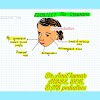METABOLIC DISORDERS MADE SIMPLE AND EASY
Von-Gierke's disease (type-1 glycogenosis) is characterized by recurrent hypoglycemia attacks with hepatomegaly, and the hypoglycemia does not respond to epinephrine or glucagon.
Pompe's disease (type-II glycogenosis) is characterized by coarse facies, hepatosplenomegaly, and a tall QRS complex, but it is not a liver glycogenosis.
Mnemonics: ABCDEF
A- Autosomal recessive
B- Biopsy of muscle (presence of vacuole that stain positive for glycogen)
C- Cardiomegaly massive
D- Defects in Acid maltase
E- Enzyme replacement therapy
(lumizyme) available for treatment
ECG (High voltage QRS with short PR intervals)
ECHO (biventricular thickening)
F- Floppy baby with macroglossia, hepatomegaly, and HCM
Muscle cramps with myoglobinuria are a hallmark of Mc Ardle's disease (type-V glycogenosis).
Mnemonics: LACTOSE-FREE
L- Lactose-free diet is given
A- Autosomal inheritance
C- Cataract (oil drop ), vitreous hemorrhage
T- Typically symptoms appear after feeding milk (after a few days or week after birth)
O- ZERO (0) effect of glucagon on hypoglycemia
S- SNHL, Soya-based formula is given
E- E coli sepsis is common
F- Fanconi syndrome (aminoaciduria, phosphaturia, proteinuria)
R- Renal tubular dysfunction
Reducing sugar is detected by the Benedict test
E- Enzyme assay for confirmation of diagnosis (galactose-1-phosphate uridyl transferase, Epimerase and galactokinase)
E- Extra prolongation of neonatal jaundice
Mnemonics: Intolerance FRUCTOse
Intolerance- introduction of fructose or sucrose leads to symptoms in affected individuals.
F- Fructose 1,6 bisphosphate aldolase (ALDOLASE B) deficiency
R- Recessive inheritance (Autosomal)
Restrict all sources of sucrose, fructose, and sorbitol from the diet
U- Urine for reducing substance positive
C- Celiac disease occurs in more than 10% of HFI
T- Table sugar is the culprit
O- Oral fructose challenge test is no longer considered for diagnostic approach.
Multiple carboxylase deficiency is due to biotin deficiency and can cause infantile refusal to feed, vomiting, seizures, ketoacidosis, and skin manifestations.
Organic acidemia can cause intractable seizures, skin rash, and lactic acidosis with hyperammonemia.
Phenylketonuria is caused by a deficiency in phenylalanine hydroxylase, and the treatment of choice is a low phenylalanine diet (tyrosine becomes an essential amino acid).
The FeCl3 test in urine of phenylketonuria gives a green color, and the urine has a mousy odor.
Mnemonics: ABCDEFGHI LM
A- Autosomal recessive
B- Body odor mousy or musty
C- Convulsions, hypertonia, irritability
D- Dental enamel change, Deficiency of PAH(phenylalanine hydroxylase)
E- Elevated levels of phenylacetate and phenylpyruvate
F- Facial peculiarity (Blond hair, blue iris, fair skin)
Ferric chloride test
G- Guthrie test, Growth retardation
I- Intellectual disability due to increased levels of toxic metabolites of phenylalanine and insufficient tyrosine
L- Low phenylalanine diet and adequate tyrosine is given
M- Microcephaly
Tay-Sachs disease is caused by a deficiency in hexosaminidase-A (alpha subunit).
Hunter's syndrome and Fabry's disease are lysosomal storage disorders that affect males (X-linked recessive).
Krabbe's disease can cause a bilateral deep bright thalamic appearance.
MNEMONICS: BILSON
13 → 13 chromosomes (looks like B)
B- 7B (ATP 76 gene involved)
B- Basal ganglia involved
(Dystonia, Dysarthria, tremor
Biopsy of Liver gold Std. for diagnosis
I → Increased urinary Cu
Impaired emotion (Emotionally Labile)
L- Liver involvement (Acute subacute /chronic)
Low ceruloplasmin Level
S→ Sensory involvement
O→ Ocular(Sunflower Cataract KF ring-Decement membrane deposit)
N→ Negative Coombs hemolytic anemia
Mnemonics: 4A
A - Autosomal recessive
A- Acid lipase deficiency
A- Accumulation of cholesterol Ester and triglycerides in histiocytic foam cells
A- Adrenal gland calcification is pathognomic.
Mnemonics: CANAMAN Disease
C- CT and MRI help in diagnosis
A- Aspartoacylase enzyme deficiency
N- NAA (N acetyl aspartic acid) deposition in brain especially white matters.
A- Ashkenazi jews
M- Macrocephaly
A- Alexander Disease is a close differential
N- No specific treatment of the disease
rAAV(recombinant Adeno associated virus) under study trial for treatment
Disease- Diffuse white matters degeneration
Mnemonics: HARTNUP
H- High protein diet used in the treatment
A- Autosomal recessive
R- Renal loss plus decreased intestinal absorption of tryptophan.
T- Tryptophan deficiency
N- Nicotinic acid used in the treatment
U- Urinary analysis of neutral amino acid helps in diagnosis
P- Pellagra-like rash
CLASSICAL HOMOCYSTINURIA
O- Ocular (ectopia lentis)
O- Osteoporosis of the spine is common
Cy- Cysthionine $ synthase (CBS) deficiency
S- Seizure may be seen
T- Thromboembolic events are common
In- Intellectual disability progressive common
E- Elevated levels of methionine and homocysteine in body fluids are diagnostic
Beta- Betaine lower homocysteine level in body fluid, used in the treatment
ALKAPTONURIA
A- Arthritis
L- Large joints involvement (shoulder, hips, knee)
C- characteristics -calcification of intervertebral disks and
narrowing of joint space
A- Aortic valvulitis, calcification of heart valve
P- Phenylalanine and tyrosine restricted diet
T- Tyrosine level normal
O- Ochronosis( dark spot on sclera
N- Nitisinone used for treatment
Uria- urine becomes black on longstanding
Hypertyrosinemia
Type1(Hepatorenal tyrosinemia)
Mnemonics- RENAL CF
R- Renal involvement
E- Elevated level of Succinylacetone in urine and blood
N- Neuropathy
Nitisinone used in treatment
A- Alpha fetoprotein elevated
L- Liver failure/hypoglycaemic
C- Cabbage like odor
F- FAH(fumeryl acetoacetate Hydroxylase) deficiency
Type 2(oculocutaneous tyrosinemia)
Painful corneal lesions and photophobia
Keratosis of palmar surface
Deficiency of tyrosine transamine
Tyrosinemia 3(Neonatal tyrosinemia)
Absence of para Hydroxyphenyl pyruvate hydroxylase
Dr.Amit Kumar
MBBS; DCH, DNB pediatrics
FAQ
What enzyme is deficient in von Gierke disease?
What are the manifestations of von Gierke's disease?
What are the symptoms of glycogen storage disease?
How is von Gierke disease diagnosed?
How do you treat von Gierke disease?
What is the cause of glycogenosis type 2?
Which enzyme is deficient in Pompe's disease type II?
What type of disease is Pompe disease?
What are the two types of Pompe disease?
What are the effects of glycogenosis type 2?
What is the other name of Type II Pompe?
What are the symptoms of galactosemia?
What is the cause of galactosemia?
What is the disease of galactosemia?
What happens in tyrosinemia?
What are the symptoms of high tyrosine?
What are the three types of tyrosinemia?
What is Tyrosinemia type 2 eye?
What type is tyrosinemia?
What causes Tyrosinosis?
What are the symptoms of alkaptonuria?
Which enzyme is deficient in alkaptonuria?
What causes classical homocystinuria?
What are the symptoms of classical homocystinuria?
Which enzyme deficiency causes classical homocystinuria?
What are the types of homocystinuria?
What is classical homocystinuria due to CBS deficiency?
What is the difference between type 1 and type 2 homocystinuria?
What is the cause of Hartnup disease?
Which amino acid is deficient in Hartnup disease?
What are symptoms of Hartnup disease?
Why is pellagra seen in Hartnup disease?
What are the signs and symptoms of Canavan disease?
What is Canavan disease disorder?
How does a person get Canavan disease?
What is Wilson's disease caused by?
What happens in Wilson's disease?
Can Wilson's disease be cured?
What deficiency causes Wilson's disease?
How is Wilson's disease diagnosed?
Is Wilson's disease serious?
What is Gaucher disease caused by?
What enzyme is deficient in Gaucher disease?
Is Gaucher disease treatable?
What are the characteristics of Gaucher disease?
What age does Gaucher disease starts?
What is the main cause of phenylketonuria?
What are 3 symptoms of phenylketonuria?
What happens to a person with phenylketonuria?
What is PKU and how is it treated?









0 Comments